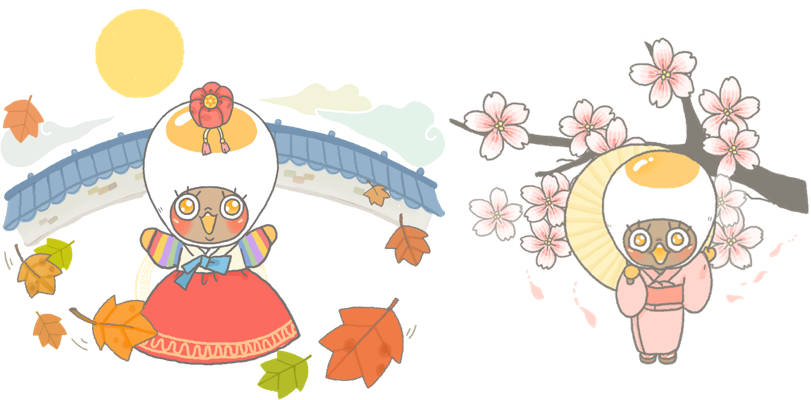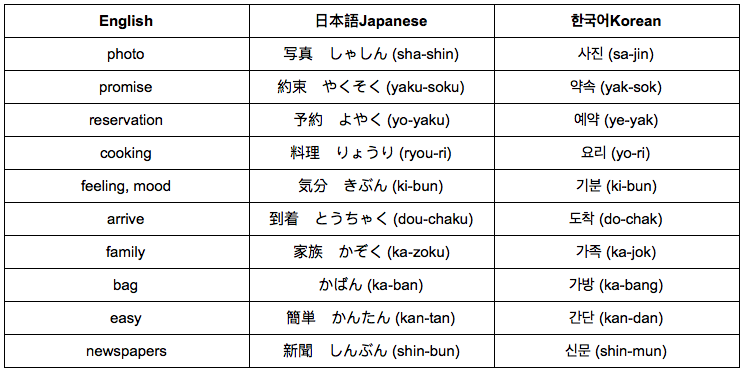Some languages, of the 6500 spoken languages in the world, share common qualities with some others; be it the grammar, the pronunciation, or the sentence structure. Thus, the learning of certain languages is easier and faster for certain language speakers. For example, Spanish (Romance) is considered one of the easiest languages for English (Germanic) speakers to learn due to the similarities in sentence structure and vocabulary.
The similarities of Korean language (Altaic) and Japanese language (Japonic*) make it easy for the speaker of these languages to learn one another. If you have already managed one of the two, why not add the other to your language list? Here are some facts that might convince you. *The inclusion of Japonic language as a member of the Altaic language family is debatable.

- Syntax / Sentence structure
Both Korean and Japanese share the same sentence structure; which is SOV (subject + object + verb) with particles linking the words in the sentence. Prior knowledge of a particular sentence structure accelerates the learning process in terms of understanding the grammar with the same syntax.
Examples of SOV structure:
Korean: ???(omma-ga)+ ????(geranbbang-eul) + ???(sassoyo). [Mum + eggbun + bought]
Japanese: ?????(okasan-ga) + ?????(dorayaki-wo) + ???(katta). [Mum + dorayaki + bought]
2. Particles ?????(jo-shi) / ??(jo-sa)
Particles ? ?????(jo-shi) / ??(jo-sa) are crucial in the grammar of both languages; they act as grammatical functions that connect the words and compose the meaning of a sentence. They can be confusing sometimes and therefore are often the fear factor for Japanese and Korean language learners. If you have mastered the particles of one of these languages, learning those of the other will be as easy as ABC.
 Particles
Particles
3. Lexical similarities ? vocabulary and pronunciation
Although both languages have different writing systems, Japanese and Korean share a considerable number of lexical similarities. Due to the influence of Chinese in the language history, Chinese characters (??kanji / ??hanja) are adopted and the common words shared are pronounced similarly. Borrowed words from other languages are also used; such as the German-derived noun ? ?????(arubaito) /?????(arebaite), that means ?part-time jobs?.
 Examples of kanji/ hanja adopted words with similar pronunciation
Examples of kanji/ hanja adopted words with similar pronunciation
4. System of honorifics ??(keigo) ???(nup-im-mal)
Japanese and Korean emphasize the importance of honorifics, which include honorific suffixes and honorific verbs. Honorifics are deemed essential and are used to express respect in many formal and social situations. One of the most common honorific suffixes is the -??(-san) / -?(-nim) attached to the name addressed.
For example: Japanese: ??(Yamada) >> ?????(Yamada -san)
Korean: ???(Kim Minji) >> ???-?(Kim Minji -nim)

5. Cultural similarities
Not only that the countries are close to each other geographically, Japanese and Korean cultures are different yet similar. Learning both languages can be absorbing as you will also learn the similarities and differences of both cultures. One of the most obvious similarities is the bowing culture; as well as the drinking culture, work ethic, and so on. Apart from that, it can be beneficial career wise if you are thinking of working or doing business in one of the two countries, as for the economic relationship between both countries.
?One language sets you in a corridor for life. Two languages open every door along the way.? ? Frank Smith
How about three, four, or more? If you are already familiar with Japanese or Korean, it?s not a bad idea to at least try learning the other. Get started by chatting with Lanny from Eggbun to learn Korean and Japanese. ?Chat to learn Japanese? is also available on IOS now!
